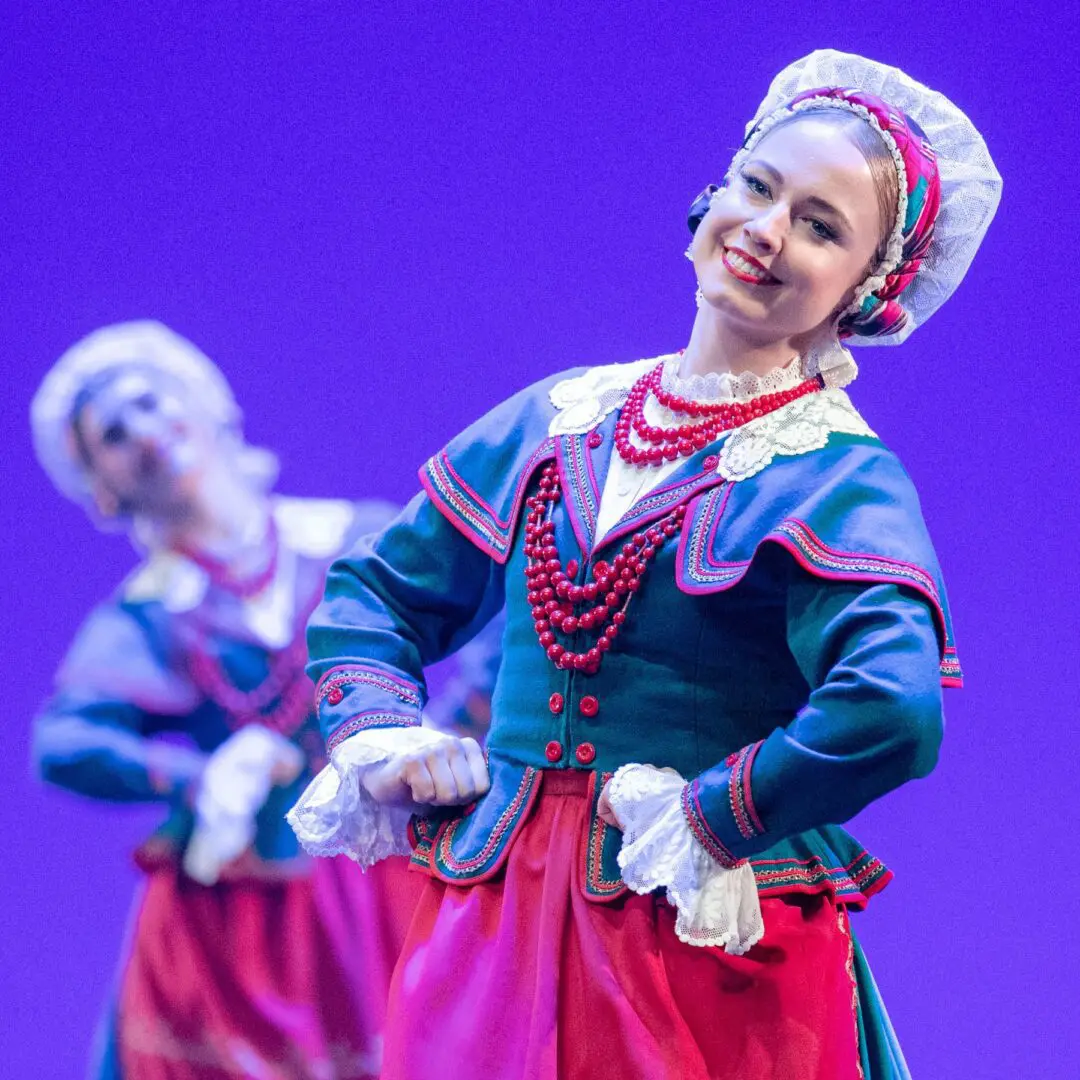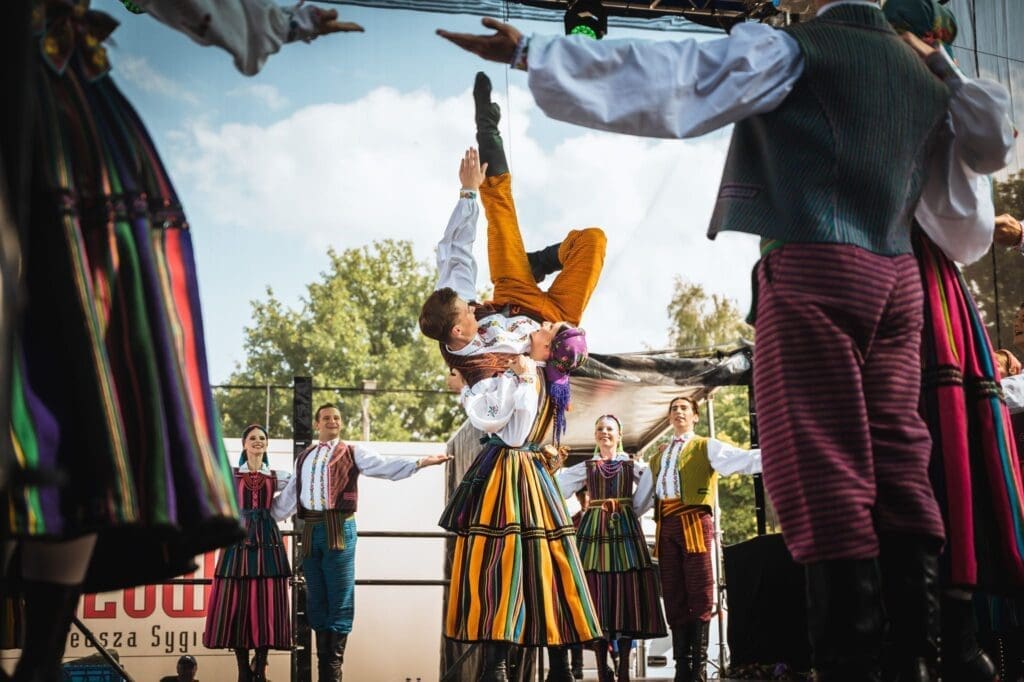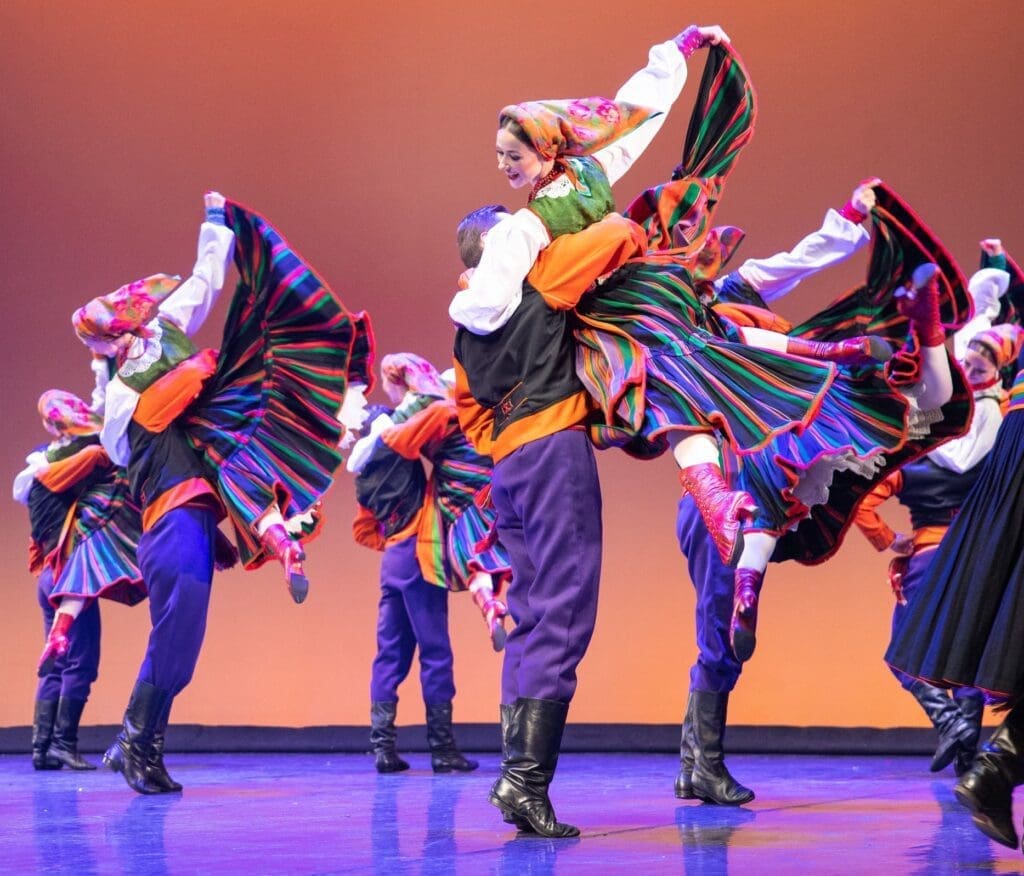
Polish Folk Dance Performances by Mazowsze are a Spectator Sport

Mazowsze Performance – Finale
Mazowsze (pronounced “mah-zove-sheh”), named after Poland’s heartland where the capital Warsaw is located, is one of two of the country’s National Folk Song and Dance ensembles. The other is Slask (pronounced “shlonsk”), which will be included in our Arts & Culture page. Both groups have made folk dance a spectator sport in thousands of performances in cities around the world. For the past 75 years, Mazowsze has been internationally recognized as Poland’s cultural ambassadors and, for thousands of people, Mazowsze concerts were their first contact with Polish culture. The Mazowsze ensemble consists of ballet-trained dancers, expert singers, and a specialized orchestra. Its national repertoire includes songs and dances from 40 distinctive ethnographic regions in Poland.
Mazowsze was formed through the efforts of its founders, Tadeusz Sygietynski (1896-1955) and his wife, Mira Ziminska-Sygietynska (1901-1997). During the bombing of Warsaw in World War II, they promised each other that, if they survived the war, they would establish a folk dance and song ensemble to preserve Polish folk culture as an essential element of its national identity. Sygietynski was a composer, conductor, and pianist who came from a family with rich musical traditions. He studied composition at the universities of Leipzig and Vienna and was a conductor for a number of opera houses. He was a great admirer of Polish folklore and learned many folk melodies during his meetings with local communities. Wanting to create a group that would convey folk traditions in an authentic and original way, Ziminska-Sygietynska wandered around the Masovian countryside (the Mazowsze group owes its name to the region) and recorded the songs he heard there.
Ziminska-Sygietynska was an actress, singer, and director who began acting at the age of seven. As a teenager, she was an accomplished singer in the PÅ‚ock cathedral and, at the age of eighteen, she made her debut in one of the most famous literary theaters in Warsaw. As a talented actress and singer, she then became a popular cabaret performer and was nicknamed “Chaplin in a skirt”. She was one of the highest-grossing stars of the Warsaw theaters and her portraits decorated ads for various luxury goods including furs, perfumes, and cars. Mira became one of the first Polish motorists and drove a Mercedes and red Bugatti cabriolet, which were famous all over Warsaw. Her quick wit and sharp tongue made her a favorite of Warsaw writers and intellectuals. She then performed on stage and later was a favorite film actress in both silent movies and “talkies”. In 1942, she was arrested and imprisoned by the Germans and released after a year. During the Warsaw Uprising against the Germans in 1944, she devoted herself to the barricades of Warsaw and gave recitals in insurgent hospitals for wounded soldiers.
The Mazowsze ensemble was established by the Ministry of Culture and Art in 1948 and, with ample funding from the Ministry, the two founders scoured the country for folk melodies, authentic costumes, folk dances, and gifted youth. As Musical Director, Tadeusz not only wrote the musical scores of old folk songs but also composed many songs that followed the native idioms of Polish folk music. As Artistic Director, Mira created brilliantly imaginative stage settings with beautiful, colorful costumes that played a prominent part in Mazowsze’s success. During each foreign concert, she established a direct dialogue with the audience by always including a song in the original language of the country where the performance took place. But the Sygietynskis did not do it alone. There were two other legends who made Mazowsze Poland’s premier cultural ambassadors. The first is Head Choreographer, Witold Zapala (1935-2018), who was a superb dancer that, it seemed, could fly through the air. He was the one who created Mazowsze’s extensive repertoire of lively dances from Poland’s ethnographic regions. The second legend is outstanding tenor and baritone, Stanislaw Jopek (1935-2006), who joined Mazowsze in 1956 and performed in every concert right up until his death in 2006.
In addition to performing regional dances from Poland’s ethnographic regions, Mazowsze’s performances almost always include Poland’s five national dances, which are the Krakowiak, Oberek, Kujawiak, Polonaise, and Mazurka. These are shown in the links below, which includes the Finale of each Mazowsze concert performance and is quite impressive.
A YouTube video of Mazowsze performing the Krakowiak can be seen here. The folk costumes shown are typical of the Krakow region.
A YouTube video of Mazowsze performing the Oberek (a polka on steroids) can be seen here. The folk costumes shown are typical of the Opoczno region.
A YouTube video of Mazowsze performing the Kujawiak can be seen here. The folk costumes shown are typical of the Kujawia region. The Kujawiak begins as a slow, flirtatious dance that transitions to an Oberek. It then sometimes transitions back to a Kujawiak but always ends with the Oberek.
A YouTube video of Mazowsze performing the Polonaise can be seen here. The Polonaise is a stately, walking dance that was a favorite of the nobility. The costumes of the nobility shown are from the 1500-1600 time period. The men’s open sleeves allow them to quickly draw their sabers. Their sashes are their fashion statement, with the best ones made by Poland’s Armenian artisans.
A YouTube video of Mazowsze performing the Mazurka can be seen here. A typical Waltz is in 3/4 time and the 1st beat of a measure is strongly accented. By contrast, the Mazurka is also 3/4 time but it is the 2nd beat of a measure that is strongly accented.
A YouTube video of Mazowsze’s finale can be seen here.
In this video, after the announcers complete their introduction and the orchestra plays the performance’s introductory melodies, you will see clips of dances from five ethnographic regions. The first is the Oberek and the dancers’ attire is from the Opoczno region. The second is a dance from the Lublin region with the performers in regional attire. The third is a dance from the Kashubia region with the performers in regional attire. The fourth is a dance from the Podhale (Highlander) region with the performers in regional attire. The fifth is from the Kujawia region and the performers are dancing the Oberek. The performance ends as a portion of the Finale is shown.
The following are photos of Mazowsze performances that display the dances and folk costumes of 24 of Poland’s ethnographic regions.

Bamberki

Jurgow

Kashubia

Krakow

Kujawia

Kurpie Green Forest

Kurpie White Forest

Limanowa

Lowicz

Lublin

Opoczno

Podegrodzie

Podhale (Highlanders)

Podlasie

Polonaise

Sannicki

Sieradz

Slask

Szamotuly

Szczawnice

Wielka Polska

Wilamowice

Wilanow

Zielona Gora ““ Wine Harvest Dance
